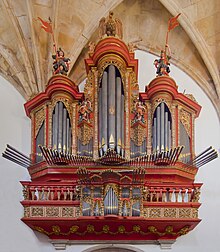Monument organ
A monument organ is a historical organ of regional or national importance. It represents a cultural asset , is a valuable part of the room and is inseparable from it. It is usually a listed building .
historical development
Just a few decades ago, the only historical and therefore worthy of protection type was that of the baroque organ. Instruments built later were redesigned according to a contemporary ideal and thus more or less destroyed. The standardization of taste has led to an impoverishment of the local organ landscape. A rethink has started in recent years. With the rediscovery of late romantic organ music , a real neo-romantic movement emerged. As a result, organs from the turn of the century before last were increasingly considered worthy of protection. Attempts are currently being made to avoid mistakes made in the post-war period and instruments from the 20th century and organs that were made in recent years are preserved. Instrument makers of every era have created good instruments, and they were able to convey the spirit and musical message of their time. So it doesn't matter whether an organ is 30 or 300 years old. Organ music corresponding to the style can be played on a monument organ in the original sound form.
Differentiation according to historical aspects
According to the degree of historical preservation, a distinction is made between the "museum monument organ" and the "grown monument organ". The two types face each other equally, as each instrument represents its own story.
The "museum monument organ" is an instrument that has never been changed for reasons of quality or often for financial reasons. The degree of originality is very high with such an instrument. An example is the organ of the monastery church in Maihingen or the great organ of the Viennese Votive Church .
In the case of the “grown monument organ”, the instrument was geared towards a specific purpose. The technical and tonal concept is conclusive, a reconstruction to an earlier situation would be purely speculative and would destroy a recognized successful organ. As an example here would Bruckner organ of the pen St. Florian to call.
Dealing with monument organs
Renovations and repairs must be proceeded very carefully. It is about preserving the grown state, which itself is also historical. The playability of the instrument must always be guaranteed. A restoration measure must always take the entire instrument into account.
The work is usually carried out under the following aspects:
- the historical material must be treated as gently as possible
- Instruments or parts thereof that are more than 100 years old are, in principle, under monument protection
- Changes and modifications are to be made of the same quality as the original substance
- Components are left in their original location as far as possible so as not to cause any consequential damage through unnecessary dismantling
- own technical and tonal ideas are to be put on hold
- Construction-related defects are not unconditionally corrected, but they are dealt with consciously
- Traces of use are left as they were found
- Serious interventions in the original substance that remove the organ from its original state are to be avoided
- Far-reaching changes are only possible for parts that have been manufactured recently
- Comprehensive documentation of the work carried out must be drawn up, which already includes the first work steps
- Original parts that have been removed are stored (close to the instrument) and must not be disposed of
- a restoration should not be visible in the appearance of the instrument
Planning and supervision
An organ expert must be called in to make decisions about a more extensive structural measure. Some regional churches even require a second expert to be called in for all work that goes beyond maintenance, cleaning and wood preservation. Before very extensive work is carried out on some projects, an expert commission is formed to advise on the possible measures or to define an overall concept based on expert opinions. Nevertheless, the restoration concept must be handled flexibly if a new historical traces are unexpectedly recognizable during dismantling. The organ building company is selected based on special experience and knowledge as well as empathy for the respective instrument. For this purpose, grants for restoration are often granted by municipal authorities and the official preservation of monuments.
Monument organs (selection)
- Organ of the Basilique de Valère in Sion
- Organ of the Rysum Church
- Organs of the Basilica of San Petronio in Bologna
- Organ of the Klosterneuburg collegiate church in Klosterneuburg
- Organ of the Tyn Church in Prague
- Organ of the castle church in Lahm (Itzgrund)
- Organ of the monastery church in Weißenau
- Organ of the St. Bavo Church in Haarlem
- Main organ of the St. Martin Basilica in Weingarten (Württemberg)
- Marien organ of the cathedral in Augsburg
- Organ of the cathedral in Schwerin
- Steinmeyer organ of the Christ Church in Mannheim
- Organ of the Christmas Church in Berlin-Haselhorst
- Ott organ of the Markuskirche in Munich
literature
- Walter Supper: Guidelines for the Protection of Old Valuable Organs. (Weilheimer Regulative). Merseburger, 1958.
- Ars organi-international journal for the organ industry. Leaflet for working on monument organs . Mettlach 1976, issue 49, ISSN 0004-2919.
- Rudolf Bruhin: The organ as a cultural asset. Swiss Federal Office of Culture, Bern 2005.
- Uwe Pape : Restoration of pneumatic organs. Pape, Berlin 1995, ISBN 3-921140-46-3 .
- Wolfgang Bodem: Restoration practice today. Specialist lecture on bodem.at
- Guidelines for the care and maintenance of monument organs. On the website of the Evangelical Church Kurhessen-Waldeck
